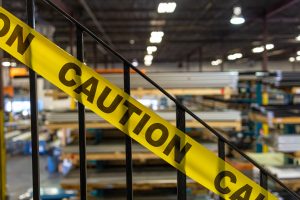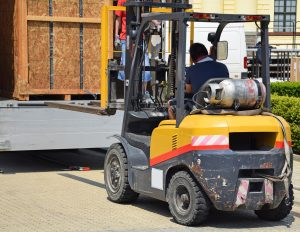This guide explores the top ten most dangerous industries to work in across Great Britain. We have collected workplace accident statistics to reveal how many non-fatal injuries were reported in recent years.
We take you through different workplaces that carry a higher risk of accidents, from hospitals to warehouses, and look at some common injuries suffered through the use of illustrative examples.
Towards the end of this article, you can learn more about accident at work compensation. We discuss when you could be eligible to make a personal injury claim following a workplace accident and how a No Win No Fee solicitor from our panel could help you with claiming compensation.
If you want to discuss claiming compensation for a workplace injury, you can contact a member of our advisory team. They can be reached by:
- Calling 020 8050 2736
- Filling out our ‘claim online‘ form to receive a callback.
- Using our live chat to ask a question.
Browse Our Guide
- Where Did We Get Our Statistics About The Most Dangerous Industries To Work In?
- Human Health and Social Work
- Manufacturing
- Transportation and Storage
- Wholesale, Retail and Vehicle Repair
- Education
- Construction
- Accommodation and Food Service
- Various Industries Including Information and Communication
- Various Industries Including Arts and Entertainment
- Water Supply, Sewerage and Waste Management
- When Can You Make An Accident At Work Claim?
- Why Claim For An Accident At Work On A No Win No Fee Basis?
- Read More About The Most Dangerous Industries To Work In
Where Did We Get Our Statistics About The Most Dangerous Industries To Work In?
We collected our data from records kept by the Health and Safety Executive (HSE), Great Britain’s regulatory body for workplace health and safety. Both employers and employees can report incidents to the HSE.
When looking at the most dangerous industries to work in, we focused on non-fatal workplace injuries. Most of the non-fatal injury statistics in this article are based on reports made by employers under the Reporting of Injuries, Diseases and Dangerous Occurrences Regulations 2013 (RIDDOR). Under this legislation, employers are required by law to report certain accidents, injuries and near-misses to the HSE.
For the statistics listed throughout this guide, we have added the total number of reports made under RIDDOR across 2018 to 2023 to reach the final number listed.
We also looked at non-fatal injury reports made by employees through the Labour Force Survey (LFS). A three-year rolling average is worked out based on the results, so the 2023 figure is based on an average of new reports made between 2021 and 2023.
You will note that the two data sets give us very different figures. Employers reported 60,645 non-fatal injuries in 2022/23, whereas the LFS reports 561,000 non-fatal injuries recorded by employees.
Bear in mind that the nature of these statistics means that not all workplace accidents will have been captured. This means that the true number of incidents is likely to be even higher than the figures we’ve shown here.
Human Health and Social Work
Human health and social work, which includes hospitals and care homes, had 58,390 work-related injuries reported under RIDDOR from 2018 to 2023. This makes them the most dangerous industry to work in, according to these statistics.
10,834 of those injuries came in 2022/23. The HSE estimates that 259 out of every 100,000 people working in health and social care were hurt at work in this period.
However, the LFS lists an estimated average of 76,000 self-reported non-fatal injuries to employees, based on their three-year rolling average.
According to reports made under RIDDOR, the biggest causes of injuries in 2022/23 were slips, trips and falls on the same level (3,252), followed by acts of violence (2,817). A health or social care employee could be at risk if their employer:
- Does not carry out an effective risk assessment.
- Provide adequate training to all staff members.
- Ensure measures are taken to reduce the risk of an attack by a volatile patient.
Manufacturing
The manufacturing industry is among the most dangerous industries to work in. The sector accounted for 10,382 incidents reported under RIDDOR in 2022/23, and a total of 53,976 from 2018 to 2023.
Again the LFS figure is higher, with a rolling average of 46,000 manufacturing accidents for 2022/23 alone.
Once again, slips, trips and falls were reported as the most common accident type under RIDDOR in 2022/23, with 2,534 reports. The second most common accident type was being struck by a moving object.
To help prevent employees from being hit by moving objects, employers could:
- Regularly maintain all workplace equipment and machinery.
- Provide staff with sufficient personal protective equipment (PPE).
- Removing or reducing any hazards they come across when performing a risk assessment.
Transportation and Storage
Working in transportation, logistics, or storage is often a physically demanding job and one involving a moving vehicle or heavy lifting. Therefore, serious injuries are a constant risk.
The transportation and storage industry reported 8,059 non-fatal accidents under RIDDOR in 2022/23, with a total of 39,882 non-fatal injuries being reported between 2018 and 2023 within this industry.
On average, as reported through the LFS, there were 29,000 non-fatal self-reported employee injuries suffered within 2022/23.
As this industry covers everything to do with moving people or items, incidents can range from bus accidents to falls in a warehouse.
Accidents could be caused by, among other things, using faulty equipment or being asked to carry an object that multiple people or a machine should lift. Employers are required under Section 4 of The Manual Handling Operations Regulations 1992 to make the risk of injury the lowest level it can reasonably be when assigning manual handling tasks.
Wholesale, Retail and Vehicle Repair
This industry covers different workplaces, including warehouses and auto repair shops.
The RIDDOR statistics show that 37,122 non-fatal accidents occurred from 2018 to 2023. In the 2022/23 reported period, there were 6,873, though the LFS figure is over ten times higher at an average of 69,000 reports.
With 1,275 reported injuries in 2022/23 under RIDDOR, manual handling accidents make up one of the main causes of harm to employees within this industry. If an employee is not trained in handling heavy materials, they could pose a risk to themselves or other workers.
Just like in manufacturing or logistics, those in wholesale, retail and vehicle repair often require proper training and robust safety practices to reduce the risk of accidents.
Injuries could be caused by, for example:
- Slipping on a wet floor because there were no warning signs.
- Receiving cuts or lacerations from faulty, sharp equipment.
- An employee striking co-workers close by with machinery they were not given effective training on using.
Education
Education is also considered one of the most dangerous occupations in the UK. Under RIDDOR, 21,042 reported non-fatal injuries to employees within this industry from 2018 to 2023, 4,845 of which were made between 2022 and 2023. Alternatively, the LFS reported an estimated 36,000 non-fatal injuries during this same period.
Slips and falls accounted for 2,099 of the reports made under RIDDOR between 2022/23. Acts of violence were recorded as the second most common accident type, with 830 reports.
An employer in an educational facility could support staff by:
- Removing or signposting any trip or fall hazards.
- Providing safeguards against violence or sufficient staff numbers to handle a potentially dangerous situation.
- Giving staff mental health support to prevent psychological harm due to workplace stress.
Construction
While construction is not chief among the most dangerous industries to work in when it comes to non-fatal accident numbers, it sees more workplace deaths than any other sector. Employers in the construction industry reported 45 fatal injuries in 2022/23 under RIDDOR. The agriculture, forestry and fishing industry, second in the list, had fewer than half the fatal incidents (21).
Between 2018 to 2023, 20,539 non-fatal incidents were reported within construction by employers under RIDDOR. 4,038 of these incidents occurred in 2022/23. The LFS estimates the average number of construction accidents to be closer to 53,000 based on their reports.
Common examples of accidents that could cause construction workers to suffer non-fatal injury on construction sites include:
- Falls from height where those in charge of the site did not assess the safety and durability of scaffolding.
- Not providing helmets or roping off areas where falling objects are a risk.
- Failing to give proper safety training to ensure employees know how to act on the construction site or how to use heavy machinery.
Accommodation and Food Service
Those working in hotels, restaurants or catering businesses may be in contact with sharp or dangerous equipment or operate machinery that requires relevant training.
As a result, injuries are a perpetual risk in the industry. Employers reported 18,781 non-fatal injuries to employees under RIDDOR between 2018 and 2023, with 3,992 cases reported in 2022/23 alone. According to the estimated average of reports made to the LFS, there were around 37,000 non-fatal injuries within this industry.
Examples of how an employee in the accommodation or food sector could be harmed include:
- Cuts and lacerations from sharp knives that are not properly secured or put away.
- Falling down stairs due to a faulty handrail or insufficient lighting.
- Slipping on a spillage that had not been cleaned due to there being no warning sign.
Various Industries Including Information and Communication
In some cases, the HSE groups together a variety of smaller sub-groups into a broad category. Between 2018 and 2023, there were 12,851 non-fatal injuries recorded across various industries, including information and communication under RIDDOR. It also covers the likes of finance and insurance, real estate, scientific and technical activities, and more. 2,616 of these reports were made in 2022/23.
The rate of fatal injuries recorded is particularly low, at just 0.1 per 100,000 employees for 2022/23. However, these roles can still be considered dangerous jobs if employers fail to follow the correct safety regulations. A workplace accident could result from:
- Tripping over exposed electrical wires that have not been secured down, tidied away or signposted.
- Suffering a shock from unprotected or faulty electrical hazards.
- Being provided with faulty equipment, such as a broken desk chair that collapses upon use.
Various Industries Including Arts and Entertainment
This group includes the likes of theatres, production studios, fairgrounds, leisure centres and sporting or adventure activities.
There have been 13,058 non-fatal incidents reported under RIDDOR between 2018 to 2023 within this industry. 2,598 of these reports were made in 2022/23.
However, there were around 10,000 self-reported injuries in 2022/23 alone, according to the figures collected for the LFS.
To prevent accidents and injuries occurring in these industries, employers must make sure they do not:
- Fail to carry out regular risk assessments.
- Ignore the warnings given by these assessments.
- Forget to regularly check equipment, especially potentially dangerous machinery that could cause a serious work injury, such as fairground rides.
Water Supply, Sewerage and Waste Management
Water supply, sewerage, and waste management is also considered one of the most dangerous jobs and industries to work in. 9,569 non-fatal employee injury reports were made by employers under RIDDOR between 2018 and 2023, with 1,957 of these reports being made in 2022/23.
The top three most common accident types recorded within this industry in 2022/23 were slips, trips and falls (653), handling, lifting and carrying (465), and being struck by a moving object (225).
Those working in water, sewerage or the waste and recycling sector could be at risk of harm from:
- Being hit by a moving object while working.
- Coming into contact with a harmful substance, such as a sharp object, used needle or contaminant, due to not being provided sufficient PPE.
- Slipping on an unsafe surface.
These are only examples for the top ten most dangerous industries to work in. If you have been injured while at work, regardless of what industry you work within, you might be able to claim compensation. Continue reading this guide to find out when you may be able to make an accident at work claim. You can also contact our advisors with any questions you may have.
When Can You Make An Accident At Work Claim?
Your employer, regardless of what industry you work in, owes you a duty of care. Section 2 of the Health and Safety at Work etc. Act 1974 describes this duty as the employer’s need to take reasonably practicable steps to keep employees safe from harm while working.
If an employer fails to adhere to this duty of care, an employee could suffer an injury while at work.
You could claim for an injury at work if you can show that:
- Your employer owed you a duty of care in the time and place that the accident occurred.
- They breached their duty.
- This directly led to the accident and you suffering physical and/or mental harm.
How Long Do You Have To Claim Accident At Work Compensation?
The Limitation Act 1980 sets out a three-year window to start legal action. This means that, generally speaking, you have three years from the accident date to submit your claim.
A select few cases may call for an exception to the rule. These apply to those under the age of 18 when injured and those lacking the mental capacity to make their own claim.
If you’d like to learn more about these time limit exceptions or to find out if your case is eligible for a workplace injury claim, just call the number at the top of this page.
Why Claim For An Accident At Work On A No Win No Fee Basis?
Even if you are not an employee in one of the most dangerous industries to work in, you could still make a compensation claim if you were injured at work due to your employer breaching their duty of care.
If you have a valid claim, one of the No Win No Fee solicitors on our panel could help you with claiming compensation. By offering to represent you under a Conditional Fee Agreement, you will not have to pay any fees for their services either upfront, while the claim is in progress, or if it fails.
If your accident at work claim succeeds, your solicitor will be entitled to a success fee. This is a small percentage of the compensation which is legally capped.
You can learn more about claiming compensation by calling or getting in touch with us today. Our advisors can even assess your case and put you through to an expert solicitor on our panel if you have reasonable grounds to sue. Contact our team today, by:
- Calling 020 8050 2736
- Filling out our ‘claim online‘ form to receive a callback.
- Using our live chat to ask a question.
Read More About The Most Dangerous Industries To Work In
If you want to know more about claiming compensation for harm suffered at work, try these guides from our collection:
- We discuss how to prevent manual handling injuries and what to do if an accident happens.
- A closer look at common injuries for construction workers and when you could claim for a building site accident.
- Our top tips on preventing an accident in the workplace.
These sites are also useful resources when thinking about workplace accidents:
- Further health and safety statistics from the HSE.
- Government advice on how to request CCTV footage of an incident.
- Medical evidence is useful for a claim, and this NHS page explains how to ask your GP for a copy of your health records.
Our report into the research we did on the most dangerous industries to work in can be found on our website. Contact our advisors today to see whether you may be able to make an accident at work claim.




